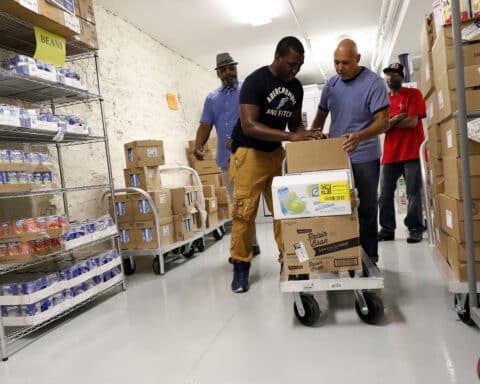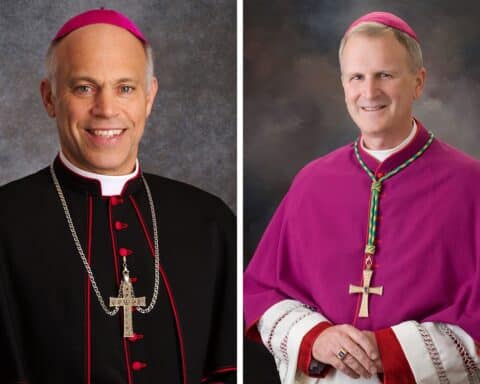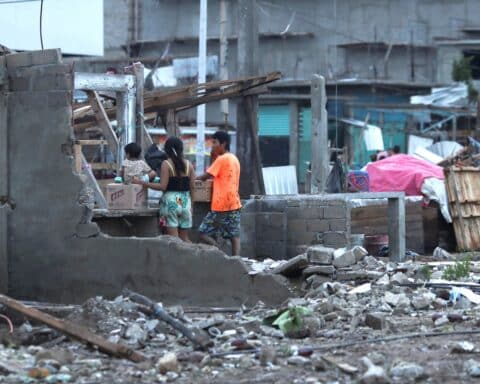It’s been a month since Hurricane Michael blew its way through the Florida Panhandle. The Category 4 storm — which produced heavy rains and winds of up to 155 mph — destroyed buildings, downed trees and power lines, and caused up to 45 deaths.
The hurricane first made landfall on Oct. 10, cutting a 20-mile wide path between Mexico Beach on the eastern side and Panama City to the west, and making its way up the East Coast. While many Catholic parishes and schools of the Diocese of Pensacola-Tallahassee suffered severe damage from the storm, the diocese’s Catholic Charities of Northwest Florida has stepped up to help the victims.
Immediate damage
St. Dominic Church in Panama City, reported pastor Father Michael Nixon, was “right in the thick of it” when the storm hit. Father Dixon opted not to evacuate, staying behind with his associate pastor, a visiting seminarian and his dog.
“It was loud. I’ll never forget the sound of our carport being torn apart and thrown hundreds of yards away,” he said.
As the storm raged, the trio read Scripture and played the guitar and sang praise songs, Father Dixon said, because “if we live or die, we’re his.”
The morning after, Father Dixon walked outside to discover the community had been devastated. “It was like a nuclear bomb went off,” he said. “Buildings were leveled, and it seemed like every other tree had fallen down or was tossed on top of buildings.”
The parish hall was “totally destroyed,” and the roof of the religious education building was gone. Much of the rectory roof had been torn off, making it unlivable. The church building survived best, losing only some shingles and one of its windows.
Across the diocese
The Catholic parishes on the eastern side of the hurricane’s path saw similar damage. Father Chris Winkeljohn is pastor of St. Joseph Church in Port Saint Joe and of Our Lady of Guadalupe Mission in Mexico Beach. His area was ordered to evacuate, so he spent the storm in Blountstown, about 50 miles north. Despite being far from the coast, he still experienced much of the action.
“We got strong winds in Blountstown,” he said. “There was a lot of noise, and trees were falling. I felt the air pressure change in my head. I was beginning to think I’d picked the wrong place to wait out the storm.”
He returned to St. Joseph to observe fallen trees and buildings washed out from the storm surge. His rectory had 38 inches of water inside, furniture strewn about with everything “covered in a black muck from the bottom of the bay.”
The parish hall had similar flooding, but the church itself avoided severe damage.
Thirteen miles away, however, Our Lady of Guadalupe Mission was a total loss, with a collapsed roof and a portion of the walls fallen. Father Winkeljohn made an attempt to rescue the Blessed Sacrament, but roofing material covered the tabernacle so he could not reach it. He had intended to return later with tools to extricate it but learned that the diocesan bishop, Bishop Bill Wack, had himself come by with some workmen and successfully removed it.
Father Winkeljohn noted that he had grown up in Florida and had experienced multiple hurricanes, “but this was by far the worst.”
Years of recovery ahead
Volunteers have helped clean up St. Joseph and remove anything left of value at Our Lady of Guadalupe. A trailer has been brought for Father Winkeljohn to live in, as he thinks it will be at least six months before the rectory can again be inhabited. He believes the community itself, however, will take years to recover.
Father Winkeljohn is grateful, however, that his St. Joseph church building is still functional. He said, “I’m back in there saying Mass. If only one of our buildings could have escaped serious damage, I’m glad it was our church.”
Father Kevin McQuone is pastor of St. John the Evangelist Church in Panama City. He was leading a pilgrimage in Italy when the storm struck, which left many of his pilgrims from the parish “distressed.”
When he returned to Panama City at the end of the week, he said, “It was like a war zone. There was devastation everywhere, with downed trees and demolished buildings.”
Communications were disrupted, leaving residents ignorant about “what’s going on, and where the resources were.”
The St. John’s buildings were flooded, some with broken roofs and smashed windows. The middle school roof had fallen in and had insulation hanging down. Father McQuone said, “It’s going to take months to get our buildings operable again.”
Catholic Charities’ efforts
After the storm, Catholic Charities of Northwest Florida went to work, executive director Matthew Knee reported, distributing such supplies as water and food, clean-up supplies and generators, and baby items at four different parish sites. St. Dominic’s was the largest distribution site. The parish is also serving hot meals.
Both St. John’s and St. Joseph’s are distributing supplies; St. John’s has also become a hub for emergency medical services.
Knee noted that 13 diocesan buildings were damaged, with three a total loss. Among them were Catholic Charities’ buildings in Panama City. Trees fell on the roofs of their administrative and food pantry facilities, the roof of their family shelter collapsed, and the windows and walls of their thrift store sustained major damage. Yet despite the challenges, he said, Catholic Charities is still serving 2,000 to 4,000 victims daily, and is planning to help with the region’s long-term recovery.
“We’ve been through many hurricanes before, but we’ve never seen one with this much damage,” he said. “We’re going to do all we can to help as many people as possible.”
Jim Graves writes from California.





